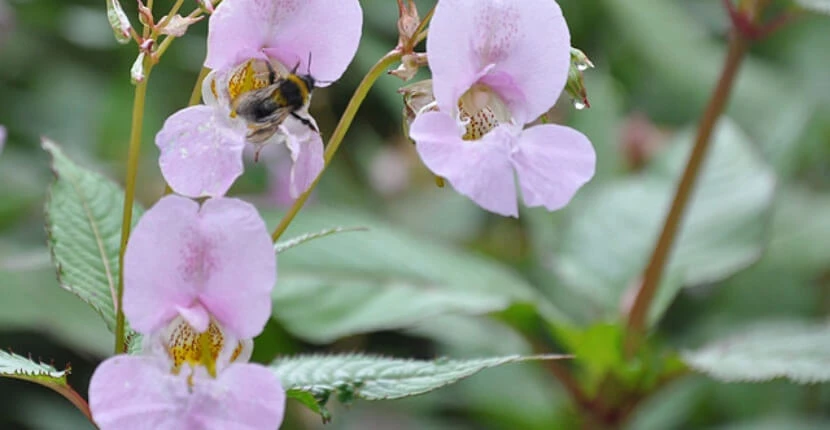
Himalayan Balsam Removal in Greater Manchester
Get in touchAt Invasive Weed, we specialise in Himalayan balsam removal in Greater Manchester WA14 1, providing safe, effective, and environmentally responsible solutions for residential, commercial, and conservation sites.
Himalayan balsam (Impatiens glandulifera) is a fast-spreading invasive plant that outcompetes native vegetation, contributes to soil erosion, and increases flood risks.
Due to its aggressive growth and rapid seed dispersal, professional removal is essential to restore biodiversity, comply with legal obligations, and prevent reinfestation.
Our certified specialists in Greater Manchester use manual removal, herbicide treatment, and long-term site management to ensure complete eradication and sustainable land restoration.
For expert Himalayan balsam removal in Greater Manchester, contact us today for a free consultation.
Why Is Himalayan Balsam a Problem in Greater Manchester?
Removal of Himalayan balsam is necessary as it poses significant ecological and environmental threats in wetland areas and riverbanks of Greater Manchester. By forming dense stands, it blocks sunlight and prevents native plant growth, leading to biodiversity loss.
Since its root system is shallow, it provides little soil stability, increasing the risk of erosion and riverbank collapse when it dies back in winter. This, in turn, contributes to flooding and sediment pollution in waterways.
In the UK, landowners are legally obligated to prevent the spread of invasive species, including Himalayan balsam.
Failure to control its spread may result in fines or enforcement action under the Wildlife and Countryside Act 1981.
What Methods Are Used for Himalayan Balsam Removal in Greater Manchester?
Effective Himalayan balsam removal requires a combination of treatment methods, such as manual pulling, herbicide treatment, grazing control, biological control, etc., based on the severity of the infestation and site conditions.
Our professional control strategies include:
Manual pulling & cutting – Ideal for smaller infestations, this involves hand-pulling plants before they set seed to prevent further spread.
Herbicide treatment – For large-scale infestations, we use approved herbicides that target Himalayan balsam without harming native plants.
Grazing control – In rural and agricultural areas, livestock such as sheep and cattle can be used to naturally suppress growth.
Biological control – Ongoing research suggests that natural pests and fungal pathogens may help reduce Himalayan balsam populations over time.
Ongoing monitoring & maintenance – Regular site inspections and follow-up treatments ensure long-term eradication and prevent regrowth.
How Much Does Himalayan Balsam Removal Cost in Greater Manchester?
Himalayan balsam removal in Greater Manchester costs range from £300 to £10,000+, depending on the size of the infestation, the treatment method, and the site conditions.
Small-scale residential removals, typically involving manual pulling and herbicide application, can cost between £300 and £1,500.
Larger commercial or conservation land infestations, requiring multiple treatment sessions and habitat restoration, can range from £2,500 to £10,000 or more.
Additional expenses may include waste disposal costs, ongoing monitoring (£500–£2,000 per year), and ecological restoration (£1,000–£5,000 for replanting native species).
To ensure an accurate estimate, we offer site surveys and tailored treatment plans based on the severity of the infestation.
Contact Invasive Weed in Greater Manchester to get customised pricing for Himalayan balsam removal.
Is a Permit Required for Greater Manchester Himalayan Balsam Removal?
Himalayan balsam removal is Greater Manchester regulated under the Wildlife and Countryside Act 1981. It is illegal to allow Himalayan balsam to spread into the wild, meaning that landowners and businesses must actively manage infestations.
Additionally, any excavated plant material or contaminated soil is classified as controlled waste under the Environmental Protection Act 1990 and must be disposed of at a licensed facility.
We ensure full legal compliance, handling all permits, waste disposal, and regulatory requirements for our clients.
How Long Does Himalayan Balsam Removal Take?
Himalayan balsam removal can take a single season for small infestations but may require multi-year treatment and monitoring for larger ones.
Manual pulling and herbicide treatments are most effective between April and July, before the plant sets seed.
More minor infestations can often be eradicated in a single growing season, whereas larger infestations may require multi-year treatment plans, especially if the seeds remain viable in the soil.
Long-term monitoring and follow-up treatments are essential, as Himalayan balsam seeds can remain dormant for up to two years.
What Are the Environmental Considerations In Himalayan Balsam Removal?
To ensure minimal disruption to native species, Himalayan balsam removal must be conducted using eco-friendly methods, such as manual pulling, targeted herbicide use, and controlled grazing.
After removal, we implement habitat restoration strategies, including replanting with native vegetation to improve soil stability and biodiversity.
Our methods comply with UK environmental protection laws, ensuring sustainable land management.
Contact Invasive Weed in Greater Manchester to get detailed information on Himalayan balsam removal.
We cover Greater Manchester
